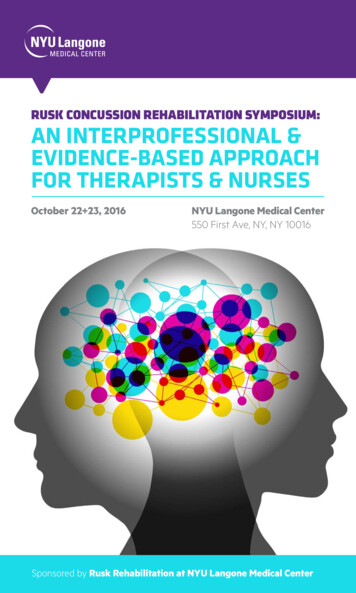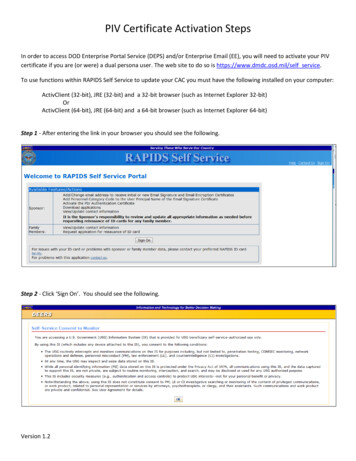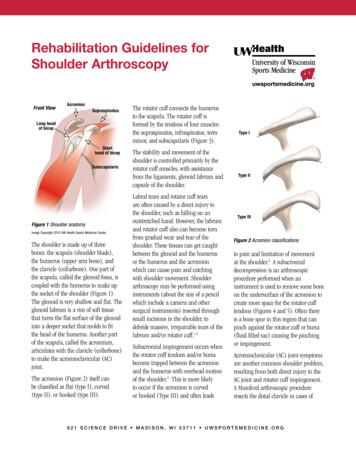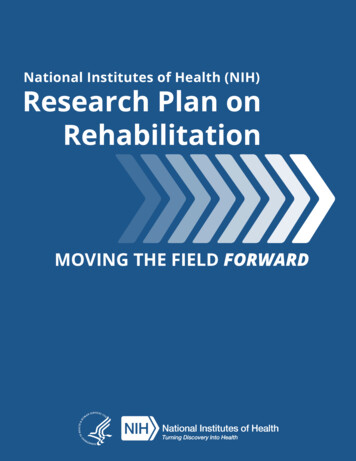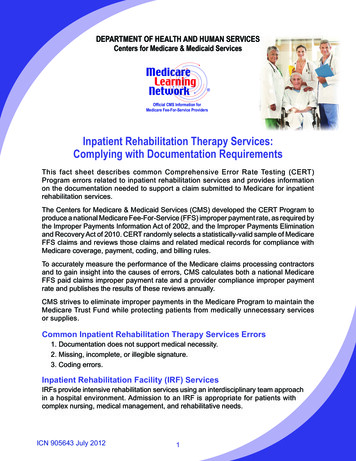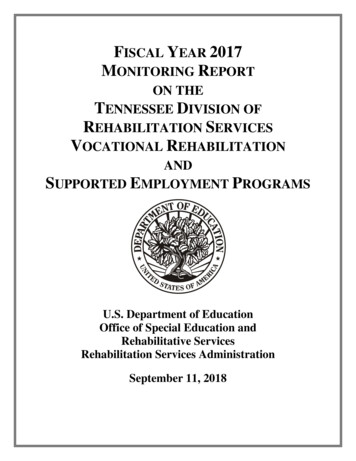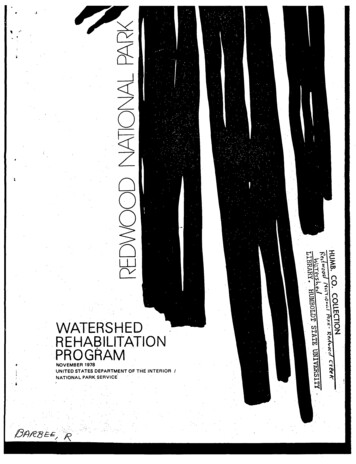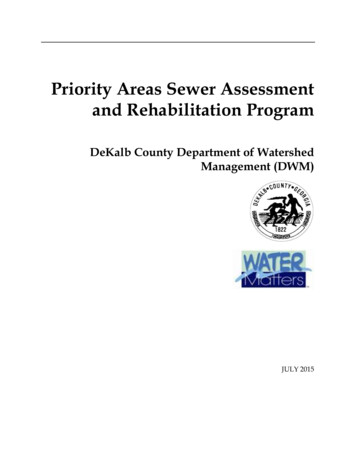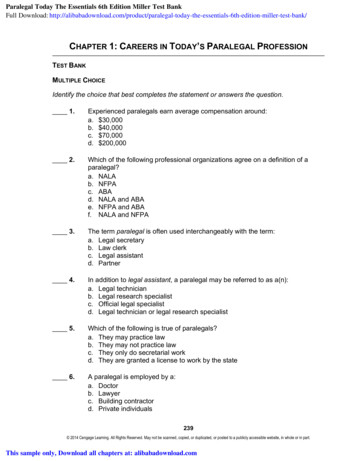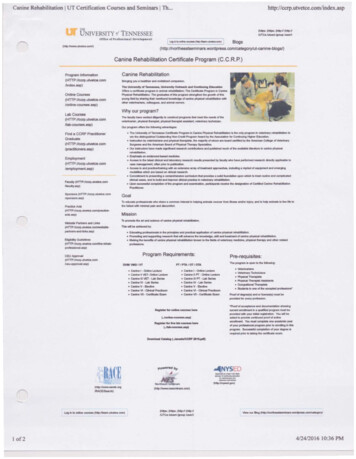
Transcription
Canine Rehabilitation I UT Certification Courses and Seminars I Th.http://ccrp.utvetce.com/index.aspTHf----/\ITC. ,.,(hapo (hapo :// (hllpJ/UNIVERSITY oJ TENNESSEE,--Offl e ef Pnfu.tl l 0.Yelep t--lA9111t. . . . . . . . . . . . ory/ut-can1ne-blogs/)Canine Rehabilitation Certificate Program (C.C.R.P.)Ptog,am lnfonnalion(HTTPJ/cap.utwtce.comnndex. sp). .---- ------. -".-.,.,,---. ----Canine Rehabilitation-glngyouo .,, ,.,ThoUnlYonilyalT- UnlYenlly - - l o g - -.,. .,,.- . -.,. ,. ., .,.,, ., ., .,, Onlone Courses(HTTPJ/cap.utvetce.oom/online-coursea up)cerltcate prC9am In arwnal r ; Thec.llcate Program lnC.I/I/try our program?Lab Courses(HTTPJ/cap.utvetce.oomOurpr . . , ./lal -coUrSeS.asp)Find a CCRP Practilion«G.Ouat (HTTPJ/ccrp.utvetce.com/practitJoners.899),.,.,.- Nan-Cr- -. . Tho. . .,ofT- ., ., la . and.,. , Thonlpy Our----- -dl-and,. mudlcl. ., ,.,. ·-----.--- --.-.,.- - &lpMlil . nt.aap)pr ., .,,,, ,.-.,c .,, tgt,e,E . , pltyOKOl.,., . ,nojo,ttrof. oy.,. Collo90of ,.,.,., , .,. . AcclN IO end p r en UllllnlMi fllnl'f of . . . . . lndudng a myriad of e,qulpmenl ,d nwging .nk:h.,. HNd on dlnioll r.,eh Conwrilrmnt I D a COti oii111Wlillw 41111k:11a,,n 1\111: a M i d upon wHdl IO. ,ouane end complcaled.,,., ., .,.,-,.Goal.,. pr .,."""'To eduClltil-p-a common .,.,. reoowr t"om . . lll'Jd/w WI;.,. and IOblllp rinalatu live ltltlOMissionTo . , . , ------)ond (KTTl'J/cap.UMllco.--.·"'----- ---.-.--------Thll.aoo-by:. e.,.,-. .,. " . , . - ,. ,. ,.,,. ., , .,,,, lwtp\'.,.,.-.Program Requirements:CEVAppro, I(KTTl'JlcapOOfflPre-requisites:1a ,. .,,.loou--eppn,,,olasp)IMIIIVMOIVT"ll"TAIOTIOTA- ,- - C.-.1-0rllMLAclue 1/ET · Lol - Cen,r,olPT - i - n CMNfflPT Lol - Calwfl/-Lol - Cri,e,V- Ub.,. CMinirt I VET ClnlN Lecan CalwV- ClniN'll - Prac:liauffl C-.VI- -.,.,.C.Jonlll CD .µi.R.\CE.· ·--- .,. .,.n.e.-.y l f c l l n . . . , l l t T b. . . . -lnOMolh .-. . -.o - oo- - -M( ). .,,. ,.,.,.,o.,r,n lftfOlmenl: -. quelled prog,am nu t beprCMCIM. .,u'fOUIinllllreQIA'donwa beYoYou-. , . . . . . , . . . . , . --.-0., . . . . . . . , . ,. . . . . la, ., .- --.a(NYSED.,,.,.,.,. ,. r an,I of2- - . . , . , ,4/24/2016 10:36 PM
Physical Therapy Continuing Education I NorthEast oduct 1119THEf'owereo byUNIVERSITY of TENNESSEE)Office of Profess Iona! DevelopmentNESPhone (US): 800-272-2044Phone (International): 001 603-329-6117HomeLive Seminars »Online Education »Northeast SeminarsShopping»CEUsCanine I: Introduction to Canine Rehabilitation(C.C.R.P.)Contact UsLog-in to your on-linecourses hereQuick SearchSearchDetailsAfter you have completed your purchase, you will then receive an emilll with a username, [p.assword) andlink for you to begin your onllne experience with Course I: Introduction to Canine RehabilitationSeminar Search 61-seminar Contact Hours: 12.0AllLive SeminarsPrerequisites[;'iParticipant must be a Veterinarian, Veterinary Technician, Physical Therapist, Physical Therapist Assistant,WebinarsOccupational Therapist or an actively enrolled student in one these fields.aThis course Is mandatory for Veterinarians, Physical Therapists, Physical Therapist Assistants. Veterinary Technicians,Occupational Thttrapists and actively enrolled students In these fields. VideoCourse Description: OnlineBooksCanine I reviews the regulatory issues involved in this field of practice from the perspective of physical therapistsand veterinarians. The response of tissues to disuse and re-mobilization will be covered and cllnlcally applied tothe science of veterinary rehabilitation. An overview of basic comparative anatomy will be reviewed, as well as- Topic - dlnlclan --commonly seen orthopedic and neurological conditions and commonly used therapeutic interventions.Collaboration between the veterinary and physical therapy professions will be emphasized to enhance the-- state --learning experience. How to get started In the field and protocol development will be reviewed.- Month -RACE Program Approval - Program Number #120-18369Number of Hourse of CE:Veterinarians: 12 hoursVeterinary Technicians: 12 hoursJoin Our Insider's Club:Email addressOutline1. Why Physical Rehabllltatlon?GeDownload RegistrationFormUnit 1: Introduction to Physical RehabilitationUnit 2: Conditions That Can Benefit from RehabUnit 3: Additional Conditions That Can Benefit from RehabUnit 4: Question & Answer SessionDiscount RehabEquipmentClass 1: Quiz2. Introduction to Canine RehabilitationUnit 1: IntroductionUnit 2: Overview of Canine I - VIIUnit 3: Canine Rehab BackgroundUnit 4: Differences Between Human and Canine RehabUnit 5: Questions & Answer SessionClass 2: Quiz3. Responses of Musculoskeletal Tissues to Disuse & RemoblllzadonUnit 1: IntroductionUnit 2: lmmobillzatlon and RemobilizationI of 44/24/2016 9:5 I PM
Physical Therapy Continuing Education I NorthEast o.asp?product 1119,fTralnlng and Drugs on Cartilage, sule Changes with Immobilization and RemobilizationUnit 5: Response of Muscle to Reduced Use and RemobilizationUnit 6: Muscle Measurement & Changes Following Cruciate Ligament SurgeryUnit 7: Remobilization of MuscleUnit 8: Response of Ligaments and Tendons to Reduced Use & RemobilizationUnit 9: Response of Ligaments & Tendons to Stress, Mobilization, & DrugsUnit 10: Response of Bone to Reduced Use and StressUnit 11: Response of Bone to Reduced Use and StressClass 3: Quiz4. Canine Osteology a. ArthrologyUnit 1: Terminology and Shoulder RegionUnit 2: Elbow, Antebrachium. and CarpalsUnit 3: Ilium, Femur & HipUnit 4: Tibia, Fibula, Stifle, and TarsusClass 4: Quizs. canine MyologyUnit 1: The ForelimbUnit 2: The Rear limbClass S: Quiz6. NeuroanatomyUnit 1: Vertebrae Anatomy & Spinal Nerve RelationshipsUnit 2: Cervical lntumescence & Nerves of the ForelimbsUnit 3: Lumbosacral lntumescence & Nerves of the Rea llmb br. Class 6: Quiz7. Common Neurologlc ConditionsUnit 1: Signs Based on Lesion LocalizationUnit 2: Intervertebral Disc DiseaseUnit 3: Cervical, Thoracolumbar, & Lumbar DiscUnit 4: Postoperative Considerations In SpinalUnit 5: Wobbler SyndromeUnit 6: Degenerative MyelopathyUnit 7: Flbrocartllagenous Embolic MyelopathyUnit 8: Trauma & Inflammatory ConditionsUnit 9: Miscellaneous Spinal ConditionsClass 7: Quiz8. Common Ailments In the HlndllmbUnit 1: Canine Hip Dysplasia · Part IUnit 2: Canine Hip Dysplasia - Part 2Unit 3: Patella luxationsUnit 4: Cranial Cruciate InjuriesUnit 5: Cranial Cruciate Injuries - Post-surgical TreatmentsUnit 6: Fracture MangementClass 8: Quiz9. Common Conditions of the ForelimbUnit 1: Assessment of the ForelimbUnit 2: OCD ShoulderUnit 3: Biceps Tenosynovitis & lnfraspinatus ContractureUnit 4: Elbow Dysplasia & FracturesClass 9: Quiz10. canine Behavior HandlingUnit 1: Communication & BehaviorUnit 2: Aggression and Handling TipsClass 1 O: Quiz11. Canine ExaminationUnit 1: Introduction to Canine ExaminationUnit 2: Diagnosis & Interventions2of44/24/2016 9:51 PM
Physical Therapy Continuing Education I NorthEast roduct 111912. Orthopedic v1luatlonUnit 1: Initial aluatlon & Lower HindlimbsUnit 2: Stifle and HipUnit 3: The ForelimbClass 12: Quiz13. Neurologk EumlnatlonUnit 1: Neurologlc Examination of the Forelimb & Rear LimbClass 13: Quiz14. Th Team Approach / Getting StartedUnit 1: The Team Member'SUnit 2: Getting StartedUnit 3: Resources, Marketing, and Fee scheduleUnit 4: SummaryClass 14: Quiz15. Additional Resourcesa) Cranial Drawer Motionb) Olecranon Processc) Coranold Processd) Ortolanl Signe) Lumbosacral Palpationf) Femoral Ant1Vers1on and Angle of Inclinationg) Hip DysplaslaSponsorsTREADPlezoWave )lETPlezoWaw VETVetoquinol e,J'rof%s YetoquloolMEDl'.YETBi olog· CAdvanced Cellular Solut,ons3 of44/24/2016 9:51 PM
CCRP PT II - Online Lectures#1 Orthopedic Conditions and their Medical and Surgical ManagementDenis J. Maree/fin-Little, MS, DVM, DACVS, CCRPUnit 1: Orthopedic PatientsUnit 2: Orthopedic ScreeningUnit 3: Body ConformationUnit 4: Practical Orthopedic Exam: Step 1 - Disorders of the ForelimbUnit 5: Practical Orthopedic Exam: Step 1 - Disorders of the HindlimbUnit 6: Practical Orthopedic Exam: Steps 2- 02 The StifleDenis J. Maree/Jin-Little, MS, DVM, DACVS, CCRPUnit 1: Cruciate Ligament InjuriesUnit 2: Predisposing Factors, Clinical Signs, and DiagnosisUnit 3: Surgical InterventionUnit 4: Postoperative ManagementUnit 5: Patella Disorders & their CausesUnit 6: Patella - Surgical Intervention & Postop ManagementUnit 7: Questions & :15:591:35:113 The HipDenis J. Marcel/in-little, MS, DVM, DACVS, CCRPUnit 1: The Hip Joint & Hip DysplasiaUnit 2: Assess At Risk PuppiesUnit 3: Rehabilitation Guidelines0:14:580:15:200:13:000:43:184 The ElbowDenis J. Marcel/in-Little, MS, DVM, DACVS, CCRPUnit 1: Elbow DysplasiaUnit 2: Fractures and Deformities0:21:410:20:460:42:27S Fracture ManagementDenis J. Moree/Jin-little, MS, DVM, DACVS, CCRPUnit 1: Imaging-RadiographyUnit 2: Imaging - Sonography, MRI, CTUnit 3: Fracture Repair Options - ForelimbUI II l - l'I dllUI P. Udll UUUUII - fllll lUIIIIIUU11I l J. rt ULLUI I! lll!µ!III OµUUII! Jk.UIJ, IUIAI JUILJI . 61 l'l!IVI 0:15:460:12:510:22:30111)111JIU!UA!l!J1:19:42
6 BandagingDenis J. Marcellin-Little, MS, DVM, DACVS, CCRPUnit 1: BandagesUnit 2: Splints, Slings, Hobbles, & Braces0:11:510:14:270:26:18SplintingDavid Levine, PhD, PT, DPT, DABPTS, CCRPUnit 1: Splinting - Introduction and Demonstration0:19:430:19:437 Anatomy LabsDenis J. Marcel/in-Little, MS, DVM, DACVS, CCRPUnit 1: Hip and ThighUnit 2: Stifle and CrusUnit 3: Hock and TarsusUnit 4: Scapula, Shoulder, and ArmUnit S: Elbow, Forearm, and Carpus0:17:190:13:460:13:310:18:050:11:571:14:388 ZoonosesDenis J. Marcel/in-Little, MS, DVM, DACVS, CCRPUnit 1: Zoonoses0:11:510:11:519 GaitDenis J. Marcel/in-Little, MS, DVM, DACVS, CCRPUnit 1: Walk, Pace, Trot, & GallopUnit 2: Kinetic Analysis0:12:130:13:460:25:5910 Neurologic Conditions & their ManagementDenis J. Marcel/in-Little, MS, DVM, DACVS, CCRPUnit 1: Signs and ExaminationUnit 2: NeuroanatomyUnit 3: Neurologic Conditions: MonoparesisUnit 4: Neurologic Conditions: Paraparesis - Part 1Unit 5: Neurologic Conditions: Paraparesis - Part 2Unit 6: Neurologic Conditions: Tetraparesis, Wobblers, & Congenital AnomUnit 7: General Rehabilitation 350:12:351:48:0711 Managing Chronic Pain in DogsDenis J. Morcellin-LittlP. MS. DVM. DACVS. CCRPUI Ill L U!,ll:!Udl ll II Ill!, 111 UUI,!!,Ullll !. o.-- fUl!l l!gl!lll!l ll Jll!µ!Unit 3: Pharmacologic Treatment of OA PainUnit 4: The Four StagesU Ub , 0 .lJ.0J0:10:530:18:000:52:51
12 Acute & Chronic InflammationDavid Levine, PhD, PT, DPT, DABPTS, CCRPUnit 1: Signs & causesUnit 2: Acute InflammationUnit 3: Chronic InflammationUnit 4: Acute vs. Chronic Inflammation0:10:300:09:510:18:060:07:110:45:3813 Range of Motion & StretchingDarryl L. Mil/is, MS, DVM, DACVS, CCRP, DACVSMRUnit 1: Range of Motion - Goals & BenefitsUnit 2: Range of Motion - ExamplesUnit 3: Stretching - Goals & BenefitsUnit 4: Stretching - Examples0:14:140:19:110:14:070:15:291:03:0114 Exercises to Enhance ProprioceptionDarryl L. Millis, MS, DVM, DACVS, CCRP, DACVSMRUnit 1: The Science of ProprioceptionUnit 2: Proprioceptive Training0:23:090:22:350:45:4415 Assessing Treatment OutcomesDavid Levine, PhD, PT, DPT, DABPTS, CCRPUnit 1: Measuring OutcomesUnit 2: Static Weight & GaitUnit 3: Muscle GirthUnit 4: Joint Function & Goniometry0:11:330:18:410:10:440:18:180:59:1616 BioPhysical Agents and Therapeutic ModalitiesDavid Levine, PT, PhD, OPT, OABPTS, CCRP, Cert. ONUnit 1: Superficial Heating AgentsUnit 2: CryotherapyUnit 3: Therapeutic UltrasoundUnit 4: Electrical r TherapyDarryl L. Millis, MS, OVM, DACVS, CCRP, OACVSMRUnit 1: PrinciplesUnit 2: ResearchUllll .5. I VU!:!!. ur ld!.l:!I !,0:22:52n-1q-17U.l!!'!l.OJ.JI
17 Aquatic ExercisesDarryl L. Millis, MS, DVM, DACVS, CCRP, DACVSMRUnit 1: Benefits & GuidelinesUnit 2: Physical Properties of WaterUnit 3: EquipmentUnit 4: Getting the Dog in the WaterUnit 5: Aquatic 3918 Therapeutic ExercisesDarryl L. Millis, MS, DVM, DACVS, CCRP, DACVSMRUnit 1: Goals and BenefitsUnit 2: Standing ExercisesUnit 3: Walking & Treadmill ExercisesUnit 4: Additional Active ExercisesUnit 5: Weights and TherabandUnit 6: Core Strengthening, Ball Playing, & Cat 11:24:1219 Kinematics of Selected Therapeutic Exercises in DogsDarryl L. Millis, MS, DVM, DACVS, CCRP, DACVSMRUnit 1: Ground vs. Treadmill WalkingUnit 2: Stairs & InclinesUnit 3: Dancing & WheelbarrowingUnit 4: Cavaletti RailsUnit 5: Sit to Stand and 0 Exercise Physiology and ConditioningDarryl L. Millis, MS, DVM, DACVS, CCRP, DACVSMRUnit 1: Muscle PhysiologyUnit 2: Training & ConditioningUnit 3: RespirationUnit 4: Cardiovascular ChangesUnit 5: Hematologic & Biochemical ChangesUnit 6: Exercise & 060:20:170:06:210:18:301:23:09TOTAL21:27:28
Physical Therapy Continuing Education I NorthEast oduct J258THEpowered byUNIVERSITY of TENNESSEE)Office of Professional DevelopmentNU--Phone (US): soo-m-2044Phone (International): 001-603-329-6117HomeLive Seminars »Online Education »Northeast SeminarsShopping»CEUsCanine U VET Online Lecture: Physical AgentModalities and Therapeutic Exercises (One VearAccess) - NEW FORMAT!Contact UsLog-in to your on-linecourses hereQuick SearchSearchDetailsSeminar SearchPrerequisitesCompletion of wmioe i colioe and participant must be a Veterinarian, Veterinary Technician, Physical Therapist,Physical Therapist Assistant, Occupational Therapist or an act.ively enrolled student in one of these fields.PLEASE NOTE: Online lectures for.canine.land Canine VET ll must be completed befQa: you attend I.ABS.This course is requiredfor Veterinarians and Veterinary Technidans and actlvely enrolled students in these fields. Thiscourse required of Physical Therapists, Physical Therapist .4ssistants and Occupational Therapists or active/yenrolled students In one ofthese fields but it can be used to fulfill the Canine V requirement.This course will provide the participant with the didactic material for selected physical agent modalities used incanine physical rehabllltatlon. Superficial heating and cooling agents, therapeutic ultrasound, extracorporealshockwave treatment, laser therapy, and electrical stimulation will be covered as well as theoretical clinical IiAllLive Seminars[;":.IWebinarsaOnlineibVideo Books-Topic -applications with cases. This course also provides the participant with the basic skllls necessary to prescribe andprovide therapeutic exercise programs for dogs. Benefits and risks associated with therapeutic exercise programswill be covered along with outcome assessment of exercise programs. Topics covered include Joint biomechanics,exercise physiology, range of motion and stretching, gait training, strengthening exercises, balance and- State··proprioceptive exercises, aquatic exercises, and exercises for wellness/prevention. Outcome measures(goniometry, circumferential measurements, etc.) will also be covered in this course.- Month·· Clinician -SearchOutlineJoin Our Insider's Club:canine n YET onune Lecture·Physical Agent Modalities and Therapeutic ExercisesEmail addressLecture breakdown, Part 1:UnitTitleInstructor Time:Unit 01Acute and Chronic InflammationLevine0:48:57Unit 02Regulatory IssuesLevine0:12:24Unit 03Physical Agents: ModalitiesLevine0:41 :45Unit 04Principles of Heat as Therapeutic ModalitiesLevine0:32:21Unit 05Principles of Cold as Therapeutic AgentLevine0:44:01Unit 06Therapeutic Ultrasound In Small Animal PracticeLevine1:16:15Unit 07ElectrotherapyLevine1:S2:39Unit 08Laser TherapyArza/Millis 1:S6:47Unit 09Extracorporeal 5hockwave TherapyMlllis/Oruml :10:13Unit 10Massage In Small Animal PracticeLevine0:28:03Total Online Lecture: 9:43:25GeDownload RegistrationFormDiscount RehabEquipment 20 question quiz (Completion required prior to attending labs) downloadable handout print certificate of completion for lecture only after completing quiz (Note: you will receive your full CEcertificate for 40 hours of lab/lecture after completion of lab section of this course which Is RACE approved)Lecture breakdown, Part 2:UnitI of4TitleInstructorTime:4/24/2016 I0:08 PM
Physical Therapy Continuing Education I NorthEast SeminarsMIiiisMIiiisUnit 03 Assessing Treatment OutcomesLevineUnit 04 Aquatic ExercisesMUiisUnit OS Therapeutic ExercisesMillisUnit 06 Joint Mobilizations and End FeelsGrossUnit 07 Basic Science of Physical Therapy Anatomy & BiomechanicsMllllsUnit 08 Kinematles of selected Therapeutic Exercises In DogsMillisUnit 09 Exercise Physiology & ConditioningMIiiis9:11:43Total Lecture:, , , I I·,c,of Motion and Stretching.e to Enhance asp?product 12581:02:S80 23:09 20 question quiz (Completion required prior to attending labs) downloadable handout print certiflcatt! of completion for lecture only after completing quiz (Note: you wlll receive your full CEcertificate for 40 hours of lab/lecture after completion of lab section of this course which Is RACE approved)Learning ObjectivesAftt!r successful completion of this course, the participant should be able to:1.2.3.4.S.6.7.8.9.10.11 .1213.14.15.16.17.18.19.20.21.Describe the differences in acute and chronic Inflammation and the proper signs of each.Understand the basic regulatory issues Involved with canine rehabilitation.Demonstrate proper understanding of the general guidelines when using physical agents as modalities.Understand the principles of heat as therapeutic agent Including Its biological effects.Understand the principles of cold as therapeutic agent Including Its biological effects.Describe the typical parameters used In therapeutic ultrasound in small animal practice.Describe safe technique in preparing and applying ultrasound on dogs and understand both the thermaland non-thermal effects of ultrasound.Understand the basic principles of electrical stimulation Including parameters, electrodes, motor stimulation,sensory stimulation, and edema reduction.Understand the basic principles of laser therapy in veterinary practice and demonstrate proper knowledgeof parameters for Indicated pathologies.Understand the basic principles of extracorporeal shockwave therapy in veterinary practice and demonstrateproper knowledge of parameters for indicated pathologies.Describe techniques of massage In small animal practice Including Its benefits. effects and generalconsiderations.Acquire skJlls in various exercise techniques and their effects on the body Including treadmilllng, stairs andInclines. cavalMti rails, dancing, wheel barrowmg, etc.Prescribe and provide therapeutic exercise programs for dogs to Improve range of motion, strength,balance, enduranct!, and improved function.Understand the principles of proprioception and demonstrate useful proprioceptive exercises duringcanine rehabilitation.Describe various outcome measures used for the assessment of rehabilitation programs.Develop basic skills In understanding joint function and demonstrate proper tt!Chnique with goniometry.Describe the benefits and physical properties of water and understand the practical use of aquatle therapyIn rehabilitationDemonstrate an understanding of how to safely progress a dog In a rehabilitation program.Develop a basic understanding of Joint moblllzatlons along with normal and abnormal end feels.Understand the normal and abnormal characteristics of canine gait and be able to descnbe each Jointrelative to different parts of a gait cycle.Describe the basic principles of splinting technlqu,s for dogsWant to sign up for uob dates? Purchase lab for YfI D & mAdditional Info Certificates of Attendance can be printed once testing Is complete and passing of an 80,t, or better. You canthen print your certificate from home. Northeast Seminars Is recognized by the RACE to offer continuing education for Veterinarians and VeterinaryTechnicians.Portions Copyright Northeast Seminars Inc. All rights reserved.Sponsors2 of44/24/2016 10:08 PM
Physical Therapy Continuing Education I NorthEast oduct 123 5THEf)owerea byUNIVERSITY 0.f TENNESSEE)Office of Profess t onal Devel opm e n tPhone (US): S00-272-2044Phone (International): 001·603·329-6117HomeLive Seminars »Online Education »Northeast SeminarsShopping»CEUsCanine m VET Lab Series: Physical Agent Modalitiesand Therapeutic Exercises - NEW FORMAT!Cont act UsLog-in to your on-linecourses hereQuick searchClick here to RegisterDetailsSeminar Search fjiAllLive Seminar sPrerequisitesCompletion of ca.nJou online and participant must be a Veterinarian. Veterinary Technician, Physical Therapist.Physical Therapist Assistant Occupational Therap15t or an actJVely enrolled student In one of these fields.REMINDER:Online lectures for Cilnlntl and m.11 must be completed before you attend LABS. CIiek links If you need to WeblnarsaOnlineVideopurchase any of your lectures.BooksThis courn Is required for Veterinorlans and Veterinary Technicians and actively enrolled students In these fields. Thiscourse /s.aQl required of Physkal Theroplsts, Physical Therapist Assistants and Occupational Therapists or activelyenrolled srudents In one of these fields but It con be used to fulfil/ the Canine V requirement-Topic - Olnician -This course will provide the participant with laboratory experiences for selected physical agent modalities used Incanine physical rehabilitation. Superficial heating and cooling ;agents, therapeutic ultrasound, extracorporealshockwave treatment laser therapy, and electrical stimulation will be covered. A palpation lab on live dogs Is- State - Month··included to review Important anatomical structures for rehabllltation. This course also provides the participantwith the basic skills necessary to prescribe and provide therapeutic exerose programs for dogs. Benefits and risksassociated With therapeutic exercise programs f X dogs will be covered. Topics covered Include exercisephysiology, range of motion and stretching, gait training, strengthening exercises, balance and proprioceptiveJoin Our Insider's Club:exercises, aquatic exercises, and exercises for wellness/prevention. Outcome measures (goniometry,Gecircumferential measurements, etc.) will also be practiced In this course. Orthopedic and neurologicalevaluation/assessment of the rehabilitation patient will also be r ewed and performed with superv,sion.OutlineLab portion breakdown;Human US labDownload RegistrationFormDiscount RehabEquipmentHuman NMES labHuman ES for pain control labHuman laser labAnimal lab (heat/cold/laser/US/estlm)Shockwave labMassageGaitOrtho labNeurolabGoniometry (forelimb)Goniometry (rearllmb)/Umb CircumferencePROM and Joint MobthzationAquatic ActivitiesI of54/24/2016 10: 16 PM
Physical Therapy Continuing Education I NorthEast oduct l235 s (Stings, Carts, WC's, etc.) rdses (ortho)Therapeutic exercises (proprioceptive)Force plate/motion analysisTOUI ub: 26 hoursNEW OUTLINE - NEW FORMAT IDay 17:30-8:00am - Breakfast and registration8:00-8:30am - Welcome/Overview8:3G-12:00pm - Morning laboratory sessions - Round Robin (SO minutes X 4)- Thera c laser/ familiarlzation with devices and processes- Therapeutic ultrasound / famllfarlzation with devices and processes- Electrical Stimulation/ famillarfzatlon with devices and processes- Shockwave therapy/ familiarization with devices and processes12:00-1:00pm - Lunch1:00-2:00pm - Case In clinic2:00 -5:00pm - Dissection LabDay27:45-8:00am - Breakfast8:00-8:30pm - Q & A and discussion8:30-12:00pm - Morning laboratory session - Round Robin (SO minutes X 4)- Therapeutic ultrasound / clinic.ii apphc.itions- Electrical st1mulatlon / clinical applications- Orthopedic examination- Neurologic examination12:00-1:00pm - Lunch1:00-2:00pm - Case In the clinic2:00-5:00pm -Afternoon laboratory session - Round Robin (40 minutes X 4)- Goniometry of the pelvic limb and thigh circumference- Goniometry of the forelimb / PROM- Therapeutic massage- Gait I force plate lab /Stance analyzerDay37:45-8:00am - Breakfast8:00-9:00am - Q & A and discussion9:00-12:00pm Morning laboratory session - Round Robin (40 minutes X 4)- Splfnts and braces- Gait Analysis- Therapeutic laser and shockwave therapy/ clinical applications- Heat and cold12:00-1 :OOpm - Lunch1:00-2:00pm - Case In Clinic2:00-3:00pm - Canine Exercise Programs3:0G-4:00pm Lecture orthoses/prostheses4:00-5:00pm - CCRP case study presentation and discussionOay47:45-8:00am Breakfast8:00-9:00am - Stem Cell/PRP Therapy lecture - Millis9:00-12:00pm Round Robin (40 minutes X4) Exercise to promote limb use. strength Exercises to promotebalance. and proprioception Ambulation assistance / sling / exercise bands / hoists / carts- Aquatic TherapyLHmlnt Olljecdves;After successful completion of this course, the participant should be able to:1. Palpate on live dogs the major muscles, boney landmarks. joints, ligaments. and other anatomlcastructures important for rehabilitation.2. Recognize differences in acute and chronic Inflammation and the proper signs of each In clinical patients.2of54/24/2016 10:16 PM
Physical Therapy Continuing Education I NorthEast oduct J235,d the basic regulatory Issues involved with canine rehablhtation.ate proper understanding of the general guldelines when using physical agents as modahbes.Apply superficial heat safely and competently as part of a laboratory experience.Apply cryotherapy safely and competently as part of a laboratory experience.Describe the typical parameters used in therapeutic ultrasound In small animal practice and demonstratesafe technique In preparing and applying ultrasound on dogs.Understand the basic principles of electrical stimulation Including parameters, electrodes, motorsbmulatlon, sensory stimulation, and edema reduction and demonstrate proper technique on dogs.Understand the basic principles of laser therapy In veter1nary practice and demonstrate proper techniqueduring treatment.Perform techniques of massage In small animal practice Including Its benefits, effects and generalconsiderations.Demonstrate various exercise techniques on dogs in safe and proficient manner.Prescribe and provide therapeutic exercise programs for dogs to Improve range of motion, strength,balance, endurance, and improved function.Understand the principles of proprioception and demonstrate useful proprioceptive e,cercises duringcanine rehabllitabon.Proficiently demonstrate the use of various outcome measures used for the assessment of rehabilitationprograms In dogs.Develop basic skills 1n understanding joint function and demonstrate proper technique with goniometryon dogs.Describe the use of aquatic therapy in rehabllltation and demonstrate proficiency in basic aquatic therapywith dogs.Demonstrate an understanding of how to safely progress a dog In a rehablhtation program.Develop a basic understanding of Joint mobilizations along with normal and abnormal end feels In dogs.Understand the normal and abnormal characteristics of canine gait and be able to describe each Jointrelative to different parts of a gait cycle.Competently perform selected orthopedlc/neurologlcal evaluation/assessment techniques on live dogs withand without pathology.f', ', !!.I nal Info VET m Labs lndude coffee breaks, lunches and handoutS. Course related products (If any) will be available at the course, however, in a llmlted quantity. Certificates of Attendance will be given to all participants and may be used for those who need C.E.U.venfication and credits. Participants will be required to sign a Release of Uabihty prior to the commencement of this seminar. Northeast Seminars is recognlzed by the RACE to offer continuing education. Location, Instructor, Oates and Cost of seminar are subject to change. For group rate accommodations, please call hotel directly and be sure to mention Northeast Seminars. A limitednumber of rooms are reserved for participants, when available, on a first-come, first-served basis. Within 30days of the course, rooms and/or rates may no longer be available. If course Is to be held at a facility, Northeastonly provides suggested hotelsKnoxville, TN - .EAQsKno Mlle, TN Hotel InfoKnoxville, TN· partdng form ro complete and submitRaleigh NC· FAQsRaleigh NC - Hotel InfoPortions CopyrlghtCI Northeast Seminars Inc. All rights reserved.SponsorsTREADD09Tn1dPlezoWave )LETPlaoWIYe Yll3 of54/24/2016 10:16 PM
http://www.neseminars.com/more-info.asp?product 1221Physical Therapy Continuing Education I NorthEast Seminars owerecl byTHEUNIVERSITY of TENNESSEE)Office of Professional Devel opmentNU--Phone (US): 800-272-2044Phone (International): 001-603-329-6117HomeLive Seminars »Online Education »No rt heast SeminarsShopping»CEUsCanine m PT Lab Serles: Physical Agent Modalitiesand Therapeutic Exercises - NEW FORMAT!Contact UsLog-in to your on-linecourses hereQuick SearchCllnl
Oct 04, 2016 · 7. Common Neurologlc Conditions Unit 1: Signs Based on Lesion Localization Unit 2: Intervertebral Disc D

